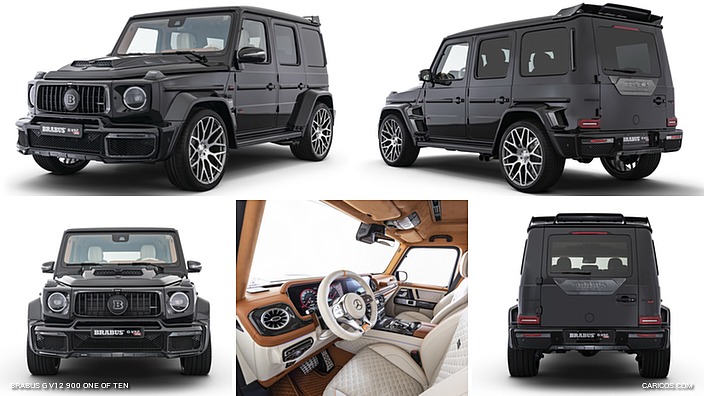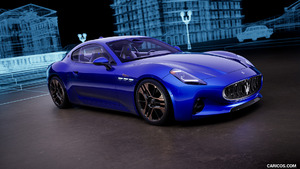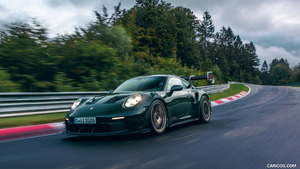BRABUS G V12 900 ONE OF TEN
- The world's most powerful twelve-cylinder SUV
- 662 kW / 900 hp, 1,500 Nm torque
- 0 – 100 km/h in just 3.8 seconds and a top speed of 280 km/h
The world's most powerful twelve-cylinder off-roader once more comes from BRABUS! The BRABUS G V12 900 "ONE OF TEN" celebrates its world premiere at the IAA 2019 in Frankfurt am Main. The new supercar will be built in a limited edition of just ten vehicles.
Fifteen years after the presentation of the first BRABUS G V12 at the Geneva Motor Show 2004, the development engineers of BRABUS again implanted a twin-turbo V12 high-performance engine into the body of the Mercedes G-Class the BRABUS way. Albeit, this time into the current W 463A model series.
The 6.3-liter increased-displacement engine producing an output of 662 kW / 900 hp (888 bhp) and 1,500 Nm (1,106 lb-ft) of torque is mated to a nine-speed automatic transmission and all-wheel drive. It gives the new supercar a performance on the road that is unique for an off-roader tipping the scales at no less than 2,660 kilograms. With a zero to 100 km/h (62 mph) sprint time of just 3.8 seconds and an electronically limited top speed of 280 km/h (174 mph), the BRABUS G V12 900 "ONE OF TEN" is the fastest road car of this model series ever built.
Of course, the new high-performance off-roader captivates not only with its tremendous power and with the exceptional road performance for a vehicle of this category. The vehicle body is enhanced with the spectacular BRABUS WIDESTAR widebody, which creates space for BRABUS "PLATINUM EDITION" hi-tech forged wheels with a diameter of 23 inches or, new, also 24-inch diameter. The electronically adjustable BRABUS Dynamic Ride Control suspension offers an ideal combination of outstanding ride quality and safe, agile handling.
 2020 BRABUS G V12 900 ONE OF TEN
2020 BRABUS G V12 900 ONE OF TEN
An exclusive BRABUS fine leather interior rounds off the luxurious appointments of the BRABUS G V12 900 "ONE OF TEN".
Prices for the new BRABUS off-roader of superlatives start at 605 055 euros (export price excluding VAT in Germany!).
Before the twelve-cylinder engine, which normally powers the Mercedes S 600 L with a rated output of 390 kW / 530 hp (523 bhp), was fitted into the engine bay of the current G-Class, it was thoroughly revised in our BRABUS hi-tech engine shop using state-of-the-art machining equipment. The installation of a special billet BRABUS crankshaft with longer stroke and the combination of larger cylinder bores, matching forged pistons and special precision-balanced billet connecting rods result in a displacement increase from stock 6.0 to 6.3 liters (366 to 384 cu in).
Changes to the engine peripherals also play a major role in the tremendous power output. The two production turbos are replaced by turbos with larger compressor unit and modified exhaust manifolds, which produce a higher boost pressure than the production components. The conversion includes downpipes with a diameter of 80 millimeters (3.1 in), free-flow metal catalysts and a BRABUS stainless high-performance exhaust system with actively controlled flaps. Thanks to the integrated sound management, the driver can choose between a throaty V12 exhaust note in 'Sport' mode and the discreet sound in "Coming Home" mode. The all- stainless exhaust system is also a visual treat. The two black-chromed tailpipes on the IAA show car exiting in front of the rear wheels on either side also add some visually thrilling highlights.
Just as important is an optimal air supply for the engine. To this end, the BRABUS power unit engineers developed the BRABUS 900 intake module. The new intake manifold includes a special air filter box with larger cross-section and special filters, as well as "Gold Heat Reflection" sheathing to lower the temperature.
The reprogrammed engine electronics with special mapping for injection and ignition as well a modified boost pressure control coordinate the perfect interaction of the high-performance components and in this way lend the high-end engine a unique combination of explosive power delivery and the hallmark smooth running of a V12. Technology partner MOTUL supplies the hi-tech lubricants for the entire powertrain.
As the result of the extensive work, the BRABUS 900 6.3 V12 Biturbo engine delivers unparalleled performance figures: The peak output of 662 kW / 900 hp (888 bhp) is on tap at a low 5,500 rpm. Even more phenomenal is the peak torque of 1,500 Nm (1,106 lb-ft) at 4,200 rpm. This figure is limited electronically in the vehicle to 1,200 Nm (885 lb-ft).
The power is sent to all four wheels by a nine-speed automatic transmission, which can be shifted even more precisely with the BRABUS RACE paddle shifters on the steering wheel.
The vehicle performance speaks for itself: From rest, the BRABUS G V12 900 "ONE OF TEN" shoots to 100 km/h (62 mph) in just 3.8 seconds. The top speed is electronically limited to 280 km/h (174 mph). Accordingly, the new supercar is also equipped with a BRABUS speedometer with 300-km/h (186-mph) scale.
A wider track optimizes the handling and driving safety at these speeds and consequently the new supercar is fitted with the thrilling BRABUS WIDESTAR widebody. The strikingly styled fender flares add ten centimeters (4 in) to the width of the body and thereby offer plenty of space for massive forged wheels with diameters of 23 or 24 inches.
The BRABUS G V12 900 "ONE OF TEN" on show at the IAA 2019 in Frankfurt presents another world premiere, the new BRABUS Monoblock "PLATINUM EDITION” Z wheels with a diameter of 24 inches developed specifically for the Mercedes G-Class. As the result of being produced using hi-tech forging technology, these ten-spoke alloys offer an outstanding combination of lightweight construction and maximum strength. The BRABUS WIDESTAR widebody uses wheels ten inches wide at the front mounted with size 295/30 R 24 tires. The rear axle runs on wheels of size 12Jx24 with 355/25 R 24 tires.
Alternatively, the BRABUS G V12 900 can also be ordered with BRABUS Monoblock Y "PLATINUM EDITION“ forged wheels of sizes 10Jx23 and 12Jx23, which carry high-performance tires from technology partner Continental of sizes 295/35 ZR 23 and 335/30 ZR 23.
In both variants, the BRABUS wheels make perfect use of the space created by the flares in the fender wells. In concert with the naked-carbon air vents aft of the front and rear wheel arches, the strikingly styled BRABUS fender flares give the off-roader an appearance with great recognition value from the sides as well. The LEDs integrated into the extensions that connect the front and rear WIDESTAR fenders to the running boards illuminate the entrance areas when a door handle is pulled or the Keyless Go system is activated. The cross-braces of the front fenders also light up then in addition.
The bodywork modifications also captivate with the BRABUS fasciae at the front and rear, which precisely transition into the WIDESTAR fenders. The front element is fitted with large air intakes to provide the engine, radiators and brakes with the necessary supply of fresh air. The stylized skid plate on this supercar is made of naked carbon.
The auxiliary LED lights under the side air intakes, which on the show car are also made of naked carbon, add to the dynamic looks and optimize the active safety at the same time. The hood is given a striking upgrade with a carbon attachment featuring two integrated power bulges. This also creates space for the large V12. The BRABUS Branding Package with illuminated BRABUS logo for the radiator grille with carbon surround and additional badges on the rear end and the sides of the off-roader reveals the origin of this unique all-wheel-drive supercar.
The BRABUS roof wing with naked-carbon highlights gives the rear end of the vehicle even more exciting looks. The BRABUS rear fascia with stylized skid plate, which like the surround for the two rear reflectors was produced from naked carbon, creates a homogeneous transition to the WIDESTAR fenders, which like the front flares feature stylized naked-carbon air vents in their backs to ensure a sporty appearance. In addition, all chrome parts on the show car were painted in vehicle color. Naked-carbon covers for the side mirrors round off the sporty BRABUS look.
For a perfect combination of high ride quality and safe, sporty handling, the BRABUS G V12 900 "ONE OF TEN" is equipped with the innovative Ride Control coilover suspension, whose damping is tailored specifically to the axle loads with the twelve-cylinder engine. It is connected to the standard-fit DYNAMIC SELECT suspension controller in the cockpit, which allows dialing in various setups for the suspension, powertrain, steering and assistance systems. In addition, the ride height of the suspension can be adjusted.
The company upholstery shop created an exclusive BRABUS fine leather all-leather interior with high-precision workmanship for the BRABUS G V12 900 "ONE OF TEN" supercar. The "ONE OF TEN” plaque in the cockpit documents the strictly limited edition of this high-end off-roader. The choice of a combination of porcelain and saddle brown leather, which is highlighted with orange piping, adds a marked contrast to the black outer skin. In addition, the center sections of the seats, which feature shell-shaped quilting and perforations applied with pinpoint accuracy, are backed with fabric of that same orange hue. The glove box and the storage compartment in the center console were likewise lined with orange leather. The headliner is made from black Alcantara. It also integrates a console with three analog gauges for the rear passengers that provide information about the speed, outside temperature and time.
Further striking features in the cockpit are the BRABUS aluminum pedals and door-lock pins as well as the naked-carbon scuff plates with backlit BRABUS logo.
To facilitate access to the rear, BRABUS developed a modification, which allows opening the rear doors further, almost at an angle of 90 degrees to the vehicle body. This allows even tall passengers to get in and out more comfortably.
Fuel economy, CO2 emissions and efficiency class: BRABUS G V12 900 "ONE OF TEN": city 26.4 l/100 km, highway 14.7 l/100 km, combined: 18.9 l/100 km. Combined CO2 emissions: 433 g/km, efficiency class G.











